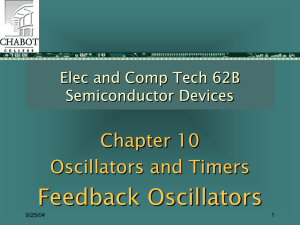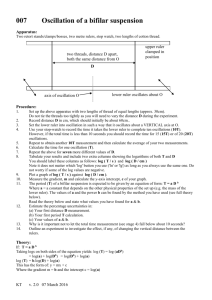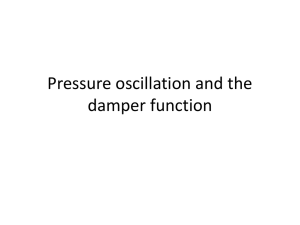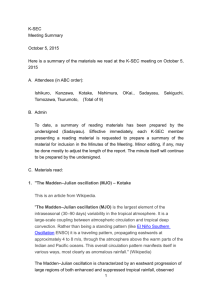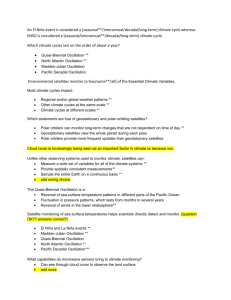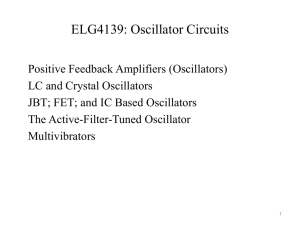The Wein-Bridge Oscillator - Electrical and Computer Engineering at
advertisement
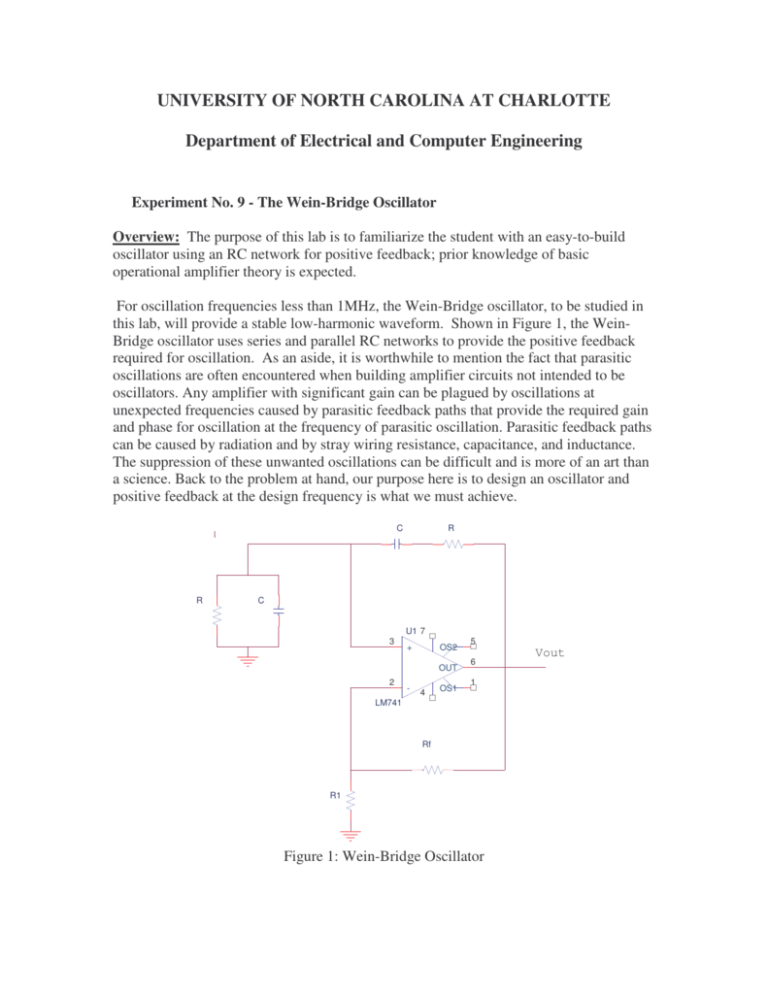
UNIVERSITY OF NORTH CAROLINA AT CHARLOTTE Department of Electrical and Computer Engineering Experiment No. 9 - The Wein-Bridge Oscillator Overview: The purpose of this lab is to familiarize the student with an easy-to-build oscillator using an RC network for positive feedback; prior knowledge of basic operational amplifier theory is expected. For oscillation frequencies less than 1MHz, the Wein-Bridge oscillator, to be studied in this lab, will provide a stable low-harmonic waveform. Shown in Figure 1, the WeinBridge oscillator uses series and parallel RC networks to provide the positive feedback required for oscillation. As an aside, it is worthwhile to mention the fact that parasitic oscillations are often encountered when building amplifier circuits not intended to be oscillators. Any amplifier with significant gain can be plagued by oscillations at unexpected frequencies caused by parasitic feedback paths that provide the required gain and phase for oscillation at the frequency of parasitic oscillation. Parasitic feedback paths can be caused by radiation and by stray wiring resistance, capacitance, and inductance. The suppression of these unwanted oscillations can be difficult and is more of an art than a science. Back to the problem at hand, our purpose here is to design an oscillator and positive feedback at the design frequency is what we must achieve. C R R C 3 U1 7 + OS2 OUT 2 LM741 - 4 OS1 5 6 1 Rf R1 Figure 1: Wein-Bridge Oscillator Vout For oscillation to occur, A must have a magnitude greater than or equal to1 and a phase of zero. For the negative feedback shown, the forward gain has a phase of zero and a magnitude of A = 1+ Rf/R1. Thus, for oscillation the magnitude of A must be greater than or equal to 1/ , and the phase of , the feedback factor, must be zero. From the circuit it can be shown that is given by R ωC 1 R− j ωC −j v β= + = v out = R −j 1 ωC + R− j ωC R − j 1 ωC −j j R− ωC 1 Thus, for the phase to be zero, R = ωC 2 R ωC 2 R ωC = R 3R 1 −j − R2 − j ωC ωC ωC 2 : or : R = −j 2 1 . ωC When this condition is true the feedback factor becomes v β= + = vout R ωC = 1 3R 3 −j ωC −j For oscillation to occur, A must be greater than 1/ ; i.e., greater than 3. With the feedback gain just large enough to cause oscillation the lowest-harmonic sinusoid is produced. When A is significantly greater than 3 an approximate square wave is produced, and when A is less than 3 oscillations will cease. The frequency of oscillation is given by fo = 1 2πRC This formula ignores the stray capacitance of connection wire as well as the internal capacitance of the bipolar transistors. When these capacitances are small in comparison with C, the above formula for resonant frequency is reasonably accurate. Also, for this configuration, the two resistors and two capacitors in the positive feedback path must be closely matched. 2 Pre-Lab - Oscillator 1. For the circuit in Figure 1, calculate the value for Rf that will yield A = 3 when R1 = 1k . Show your work in the space provided. 2. For the circuit of Figure 1, calculate the value of R for an oscillation frequency of 1.5 kHz when C = 0.01µF. Show your work in the space provided. 3. Bring a compact flash card to lab session. (INSTRUCTOR’S SIGNATURE_____________________________DATE 3 ) Lab Session - Oscillator 1. Observe the schematic shown below in Figure 2. C R R C 3 U1 7 + OS2 OUT 2 LM741 - 4 OS1 5 6 Vout 1 Rf 1k-10k R1 1k Figure 2: Wein-Bridge Oscillator using LM741 2. Before connecting this circuit, prepare the power supplies to ensure DC voltages of +15V and -15V. These voltages will be connected to pins 7 and 4, respectively. Pins 5 and 1 are provided for output-offset-nulling and will not be used in this lab. Leave them open. 3. Connect the circuit. 4. Adjust the potentiometer to a value just large enough to provide a sinusoidal output. For smaller values the oscillations will cease. Measure and record the output peak-to-peak voltage and the oscillation frequency. Save this waveform to the flash card. Remove Rf ; measure and record its value. 5. With Rf again in the circuit, increase its value until an approximate square wave output is observed. Measure and record the output peak-to-peak voltage and the oscillation frequency. Save this waveforem to the flash card. 6. With the value of Rf recorded in Step 4, calculate and record the noninverting voltage gain, A = 1+Rf/R1. 7. With Rf adjusted to provide the sinusoidal output of Step 4, measure and record to the flash card the signals at Vin(-) and Vout . 4 8. Measure and record to the flash card the signal at Vin(+). Calculate and record the feedback factor, = Vin(+) / Vout. 9. Insert a 10k load resistor at Vout . Note any affect on the oscillation frequency and voltage. Save the waveform to the flash card. 5 Lab Session – Oscillator (Data Sheet) INSTRUCTOR' S INITIALS DATE: 6 Post Lab - Oscillator 1. Compare your calculated value of from the pre-lab to its value obtained in Step 8. Are these values approximately equal? If not, explain. 2. Comment on the frequency of oscillation for the square wave in Step 5. Is it larger or smaller than that of the sinusoidal oscillation in Step 4? 3. Compare the expected value of A for oscillation as calculated in the pre-lab with that measured in Step 6. Are they approximately equal? If not, explain. 3. Using Pspice (netlist or schematics), simulate the circuit. How well does the simulation agree with the measurements taken in lab? Compare specifically the peak-to-peak output voltages, the oscillation frequencies, and the values of A and . If the simulation values are different from the lab values, explain. 7

